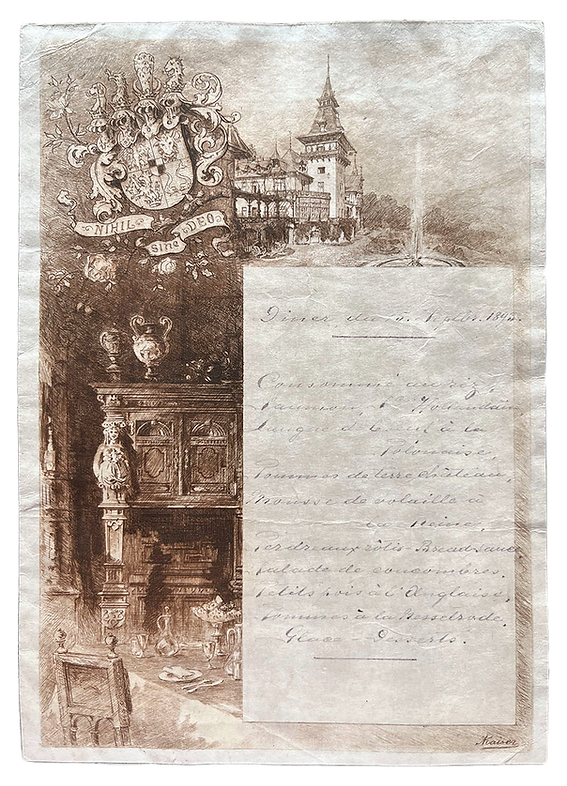
The Empress of Germany thought the castle was a “gimcrack affair” while the future Queen Marie of Romania remembered it as “having about it the quality of a cage” which shut-out the forest views and fresh mountain air.
“Everything was heavily carved, heavily draped, heavily carpeted”, the Queen remembered, “a grand abode, but too overpowering”.
Maybe so. But for the German-born King Carol I of Romania, the Peleș Castle was his dream residence, perched amongst the Carpathian Mountains. The royal country-home was just ten years-old when the King hosted this dinner with a very British serving of roast partridges, the unadventurous sounding “bread sauce” (made from onions, cloves, bay leaves, fresh white breadcrumbs, and milk) and a crispy cucumber salad.
At dinners’ conclusion came a delightful treat named after Russian diplomat Count Nesselrode who, in addition to his foreign policy successes, was a famed bon-vivant of the mid 1800s.
The dessert, Pommes à la Nesselrode, was a magical mingling of apple purée and powdered almond biscuits mixed with apple marmalade, vanilla, egg yolks and beurre manié (kneaded butter); that was then slow poached in a bain-marie. When the individual servings were unmoulded, they were smothered with a sticky sauce made from apricot marmalade thinned with almond milk.
The faded menu card is emblazoned with the royal arms of Romania with its moto: Nihil sine Deo (Nothing Without God); and depicts the grand 36-seat dining room decked out in its walnut trimmings and a ceiling with matching chairs made from Cordoba leather (horse leather from Cordoba in Spain).
And instead of mountain views, dinner guests enjoyed the site of feudal German scenes on the stained-glass windows from Munich.
Count Mijatovich, the occasional envoy of King Milan of Serbia at the time, celebrated the influence of the bestowed Germanic royals. Romanian high society, he explained:
“have a European reputation for being spendthrifts and leading somewhat extravagant and wild lives. About the middle of the nineteenth century Bucharest [the capital of Romania] was considered a hotbed of gamblers and profligates. But the influence of King Carol and Queen Elizabeth succeeded in purifying the social atmosphere of Rumania's capital. Almost every man and woman in Society acknowledged that fact with gratitude to their Majesties”.
D
inner at the Peleș Castle, Carpathian Mountains, hosted by His Majesty King Carol I of Romania.
15th September 1893

Menu
Consommé au riz
Consommé poured around a garnish of savoury rice
Saumon, Sauce Hollandaise
Salmon steaks dressed in Hollandaise Sauce made from egg yolks, butter and lemon juice
Langue de Boeuf à la Polanaise
Beef tongue marinaded in sour cream with mushrooms; and served with stuffed mushrooms
Pommes de terre chateau
Fried potato straws
Mousse de Volaille à la Reine
Chicken and truffle mousse covered with ornately shaped thin slices of cured-tongue and truffle; and set in a cock's comb jelly
Perdreaux rôtis - Bread Sauce
Roast partridges served with Bread Sauce made from breadcrumbs, cream, garlic, pepper and nutmeg
Salade de concombres
Cucumber salad
Petits pois à l'Anglaise
Baby peas tossed in butter and parsley
Pommes à la Nesselrode
Individual steamed puddings made from apples, marmalade, vanilla, crushed macaroons and egg yolks; and dressed in an apricot marmalade and almond milk sauce
Glacé - Desserts
Ice-Creams and Desserts (petit fours, fruits etc)




Peleș Castle
"The Royal Castle - amongst other monuments - is surrounded by extremely pretty landscape with gardens built on terraces, all at the edge of dense forests. The castle itself is very impressive through the riches it has accumulated: old and new canvases, old furniture, weapons, all sort of curious, everything placed with good taste. We took a long hike in the mountains, afterwards we picnicked on the green grass, surrounded by the Gypsy music. We took many pictures, and the atmosphere was extremely pleasant."
Emperor Franz Joseph
of Austria-Hungary, 1896
Roast goslings on the menu
In 1911, King Carol I served roasted goslings along with stuffed sturgeons dressed in a caper sauce when his nephew Prince Karl Anton of Hohenzollern paid a visit. The King himself was from a branch of the House of Hohenzollern, along with the German Emperor, Wilhelm II.



